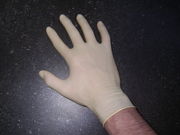
Rubber glove
Encyclopedia

Glove
A glove is a garment covering the hand. Gloves have separate sheaths or openings for each finger and the thumb; if there is an opening but no covering sheath for each finger they are called "fingerless gloves". Fingerless gloves with one large opening rather than individual openings for each...
made out of rubber
Rubber
Natural rubber, also called India rubber or caoutchouc, is an elastomer that was originally derived from latex, a milky colloid produced by some plants. The plants would be ‘tapped’, that is, an incision made into the bark of the tree and the sticky, milk colored latex sap collected and refined...
. Rubber gloves can be unsupported (rubber only) or supported (rubber coating of textile glove). Its primary purpose is protection of the hands while performing tasks involving chemicals. Rubber gloves are worn during dishwashing
Dishwashing
Dish-washing is the process of cleaning cooking utensils, dishes, cutlery and other items. This is either achieved by hand in a sink or using dishwasher and may take place in a kitchen, utility room, scullery or elsewhere...
to protect the hands from detergent
Detergent
A detergent is a surfactant or a mixture of surfactants with "cleaning properties in dilute solutions." In common usage, "detergent" refers to alkylbenzenesulfonates, a family of compounds that are similar to soap but are less affected by hard water...
and allow the use of hotter water. Health professionals use medical gloves
Medical gloves
Medical gloves are disposable gloves used during medical examinations and procedures that help prevent contamination between caregivers and patients. Medical gloves are made of different polymers including latex, nitrile rubber, vinyl and neoprene; they come unpowdered, or powdered with cornstarch...
rather than rubber gloves when performing surgical operations.
Household use
Invented by William Stewart HalstedWilliam Stewart Halsted
William Stewart Halsted was an American surgeon who emphasized strict aseptic technique during surgical procedures, was an early champion of newly discovered anesthetics, and introduced several new operations, including the radical mastectomy for breast cancer...
, household rubber gloves have been used for washing dishes and cleaning in the home since the 1960s. Many different designs of gloves have been available in a multitude of colors but traditional designs in yellow or pink with long cuffs. While these still remain the most popular patterns today, gloves can be obtained that range from wrist-length to those that are shoulder-length. There are even gloves that are pre-attached to shirts and bodysuits for added protection.
Rubber gloves are best worn with a skin tight fit which, while still allowing for the hands to breathe, makes it easier to hold objects and manipulate them. The palms and fingers usually have a raised pattern which helps provide a good grip when handling objects. Wearing gloves protects the hands from harsh detergents and other cleaning products which are used in the home and elsewhere. They also protect the wearer from bacteria involved in such tasks as the cleaning of toilets and cleaning up after pets.
These gloves are traditionally used by people cleaning in the home but are also popular with professional cleaners and for clearing up in shops, cafes and other public places. The thickness of the gloves and the long cuffs provide excellent protection for all general cleaning tasks and are useful for all chores where the hands need to be put into water, but also provide protection when vacuuming, dusting, and polishing.
The most common material used for making household gloves is latex, a form of rubber. Usually, the gloves have a cotton "flock" lining for easily taking them on and off. However, unlined gloves feel better on the skin and provide a greater ability to manipulate things. They are also available in a wider range of colors and cuff lengths. Problems with latex rubber include allergic reactions and poor protection against such substances as solvents. Other materials used to alleviate this are PVC
PVC
Polyvinyl chloride is a plastic.PVC may also refer to:*Param Vir Chakra, India's highest military honor*Peripheral venous catheter, a small, flexible tube placed into a peripheral vein in order to administer medication or fluids...
, nitrile
Nitrile rubber
Nitrile rubber, also known as Buna-N, Perbunan, or NBR, is a synthetic rubber copolymer of acrylonitrile and butadiene. Trade names include Nipol, Krynac and Europrene....
, and neoprene
Neoprene
Neoprene or polychloroprene is a family of synthetic rubbers that are produced by polymerization of chloroprene. Neoprene in general has good chemical stability, and maintains flexibility over a wide temperature range...
. Natural rubber that has been chemically treated to reduce the amount of antibody generators, such as Vytex Natural Rubber Latex
Vytex Natural Rubber Latex
Vytex Natural Rubber Latex is a brand of natural rubber latex produced and marketed by Vystar Corporation. Vytex NRL is an alternative material to petroleum-based synthetics and traditional, or Hevea, natural rubber latex...
, can be used to produce a glove that retains the properties of traditional rubber while exposing the user to significantly reduced amounts of latex allergens.

